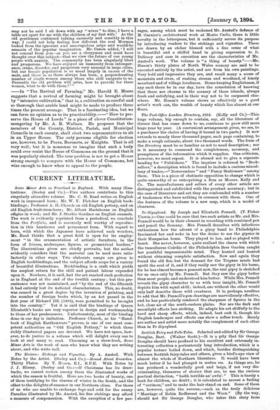CURRENT LITERATURE.
Some Minor Arts as Practised in. England. With many illus- trations. (Seeley and• Co.)—Five authors contribute to this singularly attractive volume. Mr. C. H. Read writes on English work in impressed horn ; Mr. W. Y. Fletcher on English book- bindings ; Professor A. H. Church on old English pottery, and on old English fruit-trenchers ; Mr. Albert Hartshorne on English effigies in wood; and Mr. J. Starkie Gardner on English enamels. The work is evidently reprinted from a periodical, we conclude from the Portfolio, and is assuredly well worthy of reproduc- tion in this handsome and permanent form. With regard to horn, with which the Japanese have achieved such wonders, Mr. Read thinks that a great field is open for its employ- ment " in the ornamentation of artistic furniture, in the form of friezes, arabesques. figures, or geometrical borders." The illustrations given are chiefly portraits, but the author evidently considers that the material can be used more satis- factorily in other ways. Two elaborate essays are given to English bookbindings, and the subject affords scope for a variety of beautiful illustrations. Bookbinding is a craft which yields the amplest return for the skill and patient labour expended upon it. Nowhere, it is said, had the art reached such perfection as in England at the end of the twelfth century ; but this pre- eminence was not maintained, and " by the end of the fifteenth it had entirely lost its national characteristics. This, no doubt, was caused in a great degree by the invention of printing, and the number of foreign books which, by an Act passed in the first year of Richard III. (1484), were permitted to be brought into the country." Yet it is said that the bindings of Queen Elizabeth's books are very superior in design and workmanship to those of her predecessors. Unfortunately, most of the binding done in our day is imitation. Professor Church, as his "Hand- book of English Earthenware" proves, is one of our most com- petent authorities on " Old English Pottery," to which three richly illustrated papers are devoted. We have not space, how- ever, to do justice to a volume which will delight every one to look at and many to read. Charming as a show-book, Some Minor Arts is the work of men who know what they are writing about, and who write well.










































 Previous page
Previous page